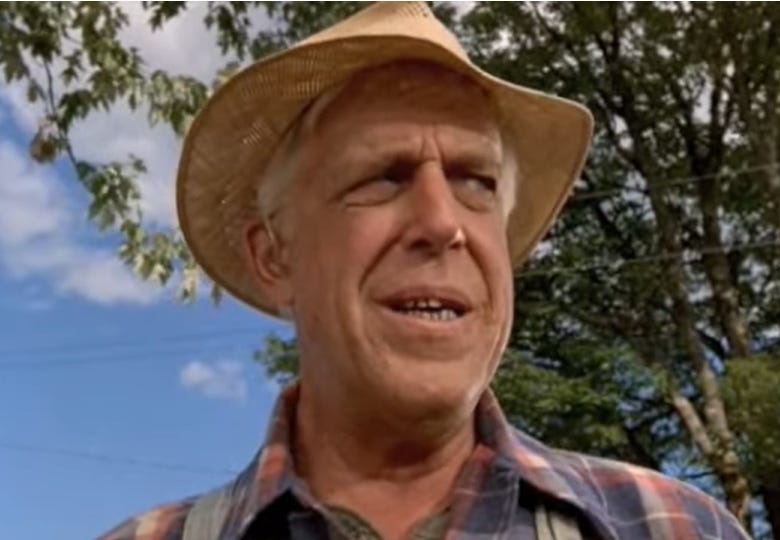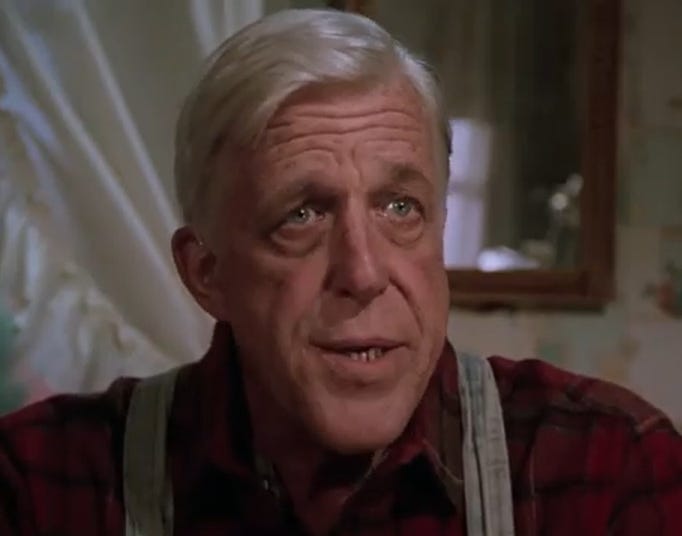There have been many high-profile movies made about people with mental disabilities. These movies, as well as the actors who portray them, often win prestigious awards. Without exception, in these movies the mental disability is not a minor plot point, it’s the whole point. The main characters in these films generally do not overcome the disability — Sling Blade doesn’t do calculus during the end credits — but sometimes they are able to eke out some redemption. And other times they end up crushing bunny rabbits or wringing the necks of women, or, in the case of Sling Blade, killing another man with (you guessed it) a sling blade. Here, the disability leads to complications for the non-mentally-challenged characters, like death.
Outside of this genre, they generally don’t make serious movies about people who are within the normal range of cognition but who are nonetheless incredibly stupid. That is the exclusive realm of comedy. Think Dumb and Dumber. Every once in a while, however, genuinely dimwitted characters do appear in dramatic films, like Fredo in The Godfather, although we realize this pretty early on. They don’t have regular characters say things like “I can handle things. I’m smart. Not like everybody says, like dumb.”
Then there is the rare movie where the rank stupidity of a character sneaks up on you. Where you encounter a character who is so patently dumb, but you only start to realize how dumb he is when you’re already halfway through the movie. By the end, with the benefit of hindsight, the stupidity leaves you breathless.
Enter Pet Sematary, the 1989 horror classic based on a Stephen King novel of the same name. If you are not familiar with the movie — or simply forgot because you saw it 35 years ago when it first came out — here’s a quick recap: The Creed family moves into a house in rural Maine because the father, Louis, just got a job as a doctor at the local university hospital. The house is situated on a road with speeding oil trucks flying by day and night. Louis has an annoying wife and an annoying daughter, as well an impossibly cute toddler son, Gage, whose cuteness only telegraphs the inevitability of his fate. In the first five seconds of the movie, we and the Creed family meet the long-faced overalled elderly neighbor from across the street, Jed Crandall (played to perfection by the one-of-a-kind Fred Gwynne).
Early in the movie, the wife and children go away to visit her parents for Thanksgiving. While the father Louis is by himself, the family cat gets run over by one of those speeding trucks. How is he going to explain this to their daughter?
This is where Jed steps in to help, providing what can only be regarded as the worst advice in the history of movies, and advice.
The movie is called Pet Sematary because there’s an actual pet cemetery located in the woods behind the Creed’s house. Jed’s long-deceased dog Spot is buried there, along with the dead pets of many heartbroken children across generations. There is nothing wrong with this pet cemetery. But when the cat dies, instead of burying it in the aforementioned “Pet Sematary,” Jed brings Louis to a second cemetery located way, way in the back, up the hill, which was apparently the burial ground used by an old Native American tribe. He doesn’t tell Louis this right away, but Jed knows that if you bury something there, it comes back to life. He also doesn’t tell Louis that when it comes back to life, it will be an unrecognizable evil version of itself. And he definitely doesn’t tell Louis that if you bury something there, there’s a really good chance that you will have unleashed an evil force into your life, which will probably, eventually, end up killing the person who does the burying, as well as, probably, eventually, everyone you love.
So, anyway, without further ado, “let’s go bury your dead cat, Louis.”
I guess I should say Spoiler Alert, but the reality is everyone could see what was going to happen long before the people in the movie.
The amazing thing is that Jed was not trying to trick Louis into doing a destructive thing when he handed him that shovel. We just figure out — pretty quickly, in fact — that Jed was just very, very stupid. How do we learn this? With the dire events cascading in real time, Jed tells Louis about the time he buried his pet dog Spot in the same Indian burial ground. Spot came back monstrous and evil. Sure enough, Louis’s cat also comes back evil, hissing and clawing all the time with yellow eyes. Later, after Louis’s son Gage gets hits by a truck, Jed tells the story of the time old man Baterman buried his son Timmy there. Timmy also came back monstrous and evil, and both Batermans ended up being incinerated in a fire.
After hearing these stories, as related by Jed, at no point does Louis ask Jed why, if Jed knew these things from direct personal experience, why on Earth did he tell Louis to bury the cat there in the first place? That advice literally killed multiple people. Fathers have been dealing with the dead cat dilemma since the beginning of TV sitcoms, and everyone knows you have two choices. You either come clean and explain to the kids what death means, or you buy a cat that looks just like the original cat and hope the kids don’t figure it out. In both cases, all the humans live.
The choice to bury the cat in the evil ground was a massive overreaction in all respects. It’s like using a Ouija board to summon a demon to ask him what time it is.
The choice of Fred Gwynne to play Jed was a clever one. He played Herman Munster, a clueless and naïve Frankenstein character in the old TV series, The Munsters, but he also later played a trial judge in My Cousin Vinny. Is he smart or is he stupid? Could go either way. The family in Pet Sematary can therefore be forgiven for not immediately recognizing Jed’s mental deficiencies. As the story unfolds, one starts to wonder whether it was Jed who painted the sign.
Even Jed’s catch phrase, “Sometimes, dead is better,” which is intended to come across as deep wisdom, is actually ludicrous. If something or someone dies in the natural course, and the only other alternative is to spawn an evil monstrosity, then ALWAYS, dead is better! ALWAYS!
The movie – screenplay by Stephen King himself – never attempts to explain why Jed does something so inexplicable. One may surmise that the evil forces lingering under the burial ground compelled him to do these things, although that is a generous reading. The way it appears on screen is that this man is so mentally deficient that he is unable to process his own obviously relevant experience and apply it to the matter at hand. Yes, Jed knows that there’s an old Indian burial ground where the thing you bury comes back to life. Can it be that that was all he remembered in that moment?
“Jed, are you sure there isn’t something else you want to tell Louis about that cemetery? Actually, let me ask it in a different way: Did those other times work out in a good way or a bad way?”
“I want you to think long and hard about your answer, Jed. Before you hand Louis that shovel.”
And that, ladies and gentlemen, is why Jed Crandall has my vote for The Dumbest Not-Mentally-Disabled Character in Movie History.
If you have other candidates for The Dumbest Not-Mentally-Disabled Character in Movie History, please include them in the comments. I don’t have the test results readily available, but in case you were wondering, Forrest Gump is not eligible.








Nope. My vote would be for Louis, who upon hopefully learning his lesson with the cat, gives it another try with Gage. Lesson learned that time? Nope. Let’s try it with my dead wife.
In all fairness to Fred Gwynne, he was absolutely delightful a few years later in The Cotton Club...